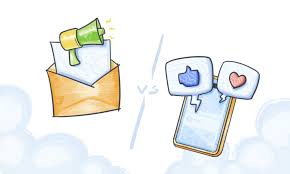
In a busy word with marketing channels, Two continue to dominate the market—email marketing vs social media marketing. Both play important roles in connecting brands with their target audience, However, in terms of conversions encouraging individuals to perform a particular action One often stands out more prominently than the other…
If you’re trying to figure out where to invest your time and budget, you’re not alone. Let’s explore the strengths and weaknesses of each, and see which channel truly drives better results.
Email Marketing: The Direct Line to Your Customers
Email marketing may not be the new trend, but don’t miscalculate its power. It’s direct, personal, and completely under your control. There are no algorithms deciding who sees your message. When someone opens your email, you’ve got their full attention—at least for a few seconds.
What makes email marketing so effective is intent. People who subscribe to your list have already shown interest. They’re more likely to engage, trust your brand, and eventually convert—whether that means making a purchase, signing up for a service, or booking a call.
Strengths of Email Marketing:
- High conversion rates: Average email marketing conversion rates range between 3–5%, and can go even higher for segmented or well-targeted campaigns.
- Control over your list: Unlike social media followers, you own your email list. It’s an asset that doesn’t disappear with an algorithm change.
- Segmentation and personalization: You can tailor messages based on behavior, interests, or past purchases.
- Automation-friendly: Welcome sequences, abandoned cart emails, and product follow-ups can all work in the background to drive results.
When Email Marketing Shines:
- Nurturing leads
- Launching new products
- Driving repeat sales
- Sharing exclusive content or offers

Social Media Marketing: Big Reach, But Is It Buying Power?
Social media is a dynamic, graphic, and very participatory medium where brands can create communities, go viral, and display their personalities. TikTok, Facebook, LinkedIn, Instagram, and other platforms have the ability to generate a lot of buzz. The catch is that chatter does not always translate into conversions.
Social media users tend to browse casually. While you can absolutely drive clicks and traffic, turning those followers into paying customers often takes more work. Organic posts may get likes and shares, but unless they’re paired with smart funnel strategies or paid ads, they might not lead to direct sales.
Strengths of Social Media Marketing:
- Massive reach: Billions of people log in daily, offering endless exposure potential.
- Visual storytelling: Perfect for lifestyle brands, fashion, beauty, and food.
- Community building: Great for brand loyalty and two-way communication.
- Real-time engagement: Respond to trends, customer questions, and feedback instantly.
Challenges With Social Media:
- Lower conversion rates: Organic conversion rates on social platforms typically hover below 1%.
- Platform dependency: Your visibility can drop overnight if an algorithm changes.
- Ad fatigue: Even paid campaigns can suffer if not consistently optimized.
- Short attention span: The scrolling culture means your window to capture interest is very brief.
So, Which One Converts Better?
When it comes to pure conversion performance, email marketing still wins—especially for small businesses, eCommerce brands, and B2B companies. It’s reliable, trackable, and highly cost-effective.
Conversely, social media serves as a crucial auxiliary tool. In the first place, it helps to expand your email list, engage your target audience, and raise awareness. The “top of the funnel” is often where people are drawn to your universe.
Knowing when and how to use each is more important than picking one over the other.
Using Social Media and Email Together to Get the Best Outcomes
The most successful digital marketers understand how to combine social media and email into a potent ecosystem. Here’s how:
Promote special deals, freebies, or lead magnets on social media to expand your email list.
Convert newsletters into LinkedIn posts or Instagram carousels to repurpose email content for social media
• Use advertisements to retarget email subscribers: Create lookalike audiences or retarget with tailored offers using your email list.
• Don’t change the message: For optimum effect and brand awareness, coordinate your campaigns across both platforms.
Conclusion
Email marketing regularly yields higher ROI and stronger conversion rates if your main objective is conversions, which means you want individuals to take a quantifiable action like making a purchase or signing up.
Don’t discount social media, though. Engagement, discovery, and brand building all depend on it. They work as a powerful team to draw in, develop, and win over your audience.
Therefore, ask “How can I use both to work smarter?” instead of “Which one is better?” That is the true magic of marketing.

